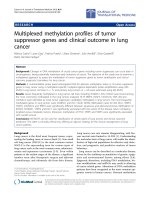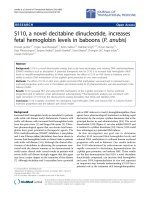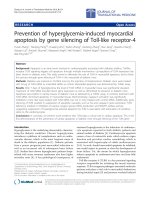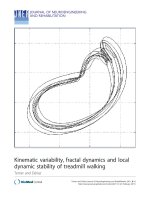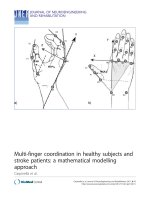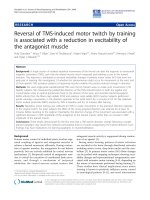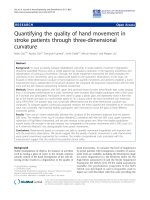Báo cáo hóa học: " Unusual magneto-optical behavior induced by local dielectric variations under localized surface plasmon excitations" potx
Bạn đang xem bản rút gọn của tài liệu. Xem và tải ngay bản đầy đủ của tài liệu tại đây (452.18 KB, 5 trang )
NANO EXPRESS Open Access
Unusual magneto-optical behavior induced by
local dielectric variations under localized surface
plasmon excitations
Juan B González-Díaz
*
, Antonio García-Martín
†
and Gaspar Armelles Reig
†
Abstract
We study the effect of global and local dielectric variations on the polarization conversion r
ps
response of ordered
nickel nanowires embedded in an alumina matrix. When considering local changes, we observe a non-
monotonous behavior of the r
ps
, its intensity unusually modified far beyond to what it is expected for a
monotonous change of the whole refractive index of the embedding medium. This is related to the local
redistribution of the electromagnetic field when a localized surface plasmon is excited. This finding may be
employed to develop and improve new biosensing magnetoplasmonic devices.
During the last years, a great effort has been devoted to
the study of metallic nanoparticles due to their distinct
optical properties with respect to that of the bulk mate-
rial [1]. These differences arise mainly from their ability
to uphold charge density oscillati ons known as localized
surface plasmons (LSPs). These spatially localized modes
may appear at a metal/dielectric interface, manifesting
themselves as optical resonances in the transmission
and reflection spectra, being their most significant fea-
ture the local enhancement of the electromagnetic (EM)
field at the metal/dielectric interface [2]. The spectral
position, width, and intensity of the optical resonances
are extremely dependent on the size, shape, particle
inter-distance, embedding environment, or material
components of the nanoparticles. In a number of works,
the influence of such parameters has been thoroughly
studiedputtingforwardthepossibility of tailoring their
optical response through the morphology of the parti-
cles [3-6].
More recently, the optical response arising from the
combination of both surface plasmon resonances and
magneto-optical (MO) properties that takes place in fer-
romagnetic nanoparticles is under intensive study. Dif-
ferent theoretical and experimental works [7-11] have
pointed out that LSPs affect the MO response, finding
an enhancement of the signal that has been usually
ascribed to a pure optical effect related to the plasmonic
excitation [10,12-14]. However, the MO activity defines
in terms of the reflectivity coefficients as F = r
ps
/r
pp
,
being r
ps
the polarization conversion and r
pp
the optical
response (when the magnetic field is applied perpendi-
cular to the sample plane). Therefore, the MO response
mayalsobeenhancedbymodifyingr
ps
.Thiswasfirst
shown in [11], where the authors suggested as a possible
origin the strong localizatio n of the EM field in the MO
active material due to the LSP excitation. The scope of
this work is to study more in detail the correspondence
between the polarization conversion and the EM field
under LSP excitations. To do so, we will theoretically
analyze the r
ps
dependence to global and local dielectric
changes of the surrounding media in peri odic ferromag-
netic nanowire arrays. We will show that the different
dielectric environments affect the EM field distribution
when the LSP is excited, consequently changing the
spectral position and intensity of the r
ps
peak. Moreover,
we will prove that variations of the refractive index in
the close vicinity of the wires extremely a ffect the r
ps
,
making its intensity much larger and/or smaller than
that obtained if the whole embedding matrix is replaced.
This is a consequence of the local redistribution of the
EM field induced by the plasmon excitation at the
metal/dielectric interface.
To investigate the influence of LSPs on the r
ps
response, we considered an ordered hexagonal array of
* Correspondence:
† Contributed equally
IMM-Instituto de Microelectrónica de Madrid (CNM-CSIC), Isaac Newton 8,
PTM, Tres Cantos, E-28760 Madrid, Spain
González-Díaz et al. Nanoscale Research Letters 2011, 6:408
/>© 2011 González-Díaz et al; license e Springer. This is an Open Access article distributed under the terms of the Creative Commons
Attribution License ( .0), which pe rmits unrestricted use, distribu tion, and reproduction in
any me dium, provided the orig inal work is properly cited.
nickel nanowires embedded in a dielectric matrix and
oriented along the z-axis. The diameter of the wires was
set to 8 0 nm, with a lattice parameter of 180 nm and a
height of 15 μm (a schematic view of the model system
can be seen on top of Figure 1a). The spectral depen-
dence of the absolute value of the polarization conver-
sion |r
ps
| was obta ined by means of a scatterin g matrix
method (SMM), modified to allow MO activity in the
polar configuration [15]. The diagonal and off-diagonal
dielectric constants of nickel were taken from [16,17],
respectively, whereas the refractive index of the dielec-
tric matrix remained energy independent. Calculations
were performed for different embedding mediums (from
n =1.7ton =1.4),showninFigure1a.Apeakcanbe
observed in all the spectra, blue-shifting and increasing
its intensity, as the refractive index decreases. This peak
is originated by an LSP excitation in the wires, as it was
pointed out in [10,11], being its spectral position related
tothevariationoftheplasmonresonancecondition
introduced by the modification of the dielectric back-
ground. We also performed additional calculations
replacing the hexagonal array of nanowires with an
effective layer. Since the dimensions of the nanostruc-
ture are much smaller than the wavelength of light, the
optical properties of the nanowires and the embedding
matrix can be merged by means of an effective medium
approximation (EMA) [18]. The results are shown in
Figure 1b. As it can be observed, the spectra show the
LSP-induced peak, but contrary to the SMM results, its
intensity decreases with the refractive index.
The main reason why both calculations do not present
similar evolutions of the polarization conversion is that
the EMA approximation cannot take into account
the strong increase of the EM field at the metallic nano-
particle. This can be better seen obtaining the EM field
distribution within the n anowires at selected wave-
lengths. To do so, a 3D finite-d ifference time-domain
(FDTD) simulation software was used (Lumerical Solu-
tions, Inc., Vancouver, Canada), the results depicted in
Figure 2 for the same parameters and refrac tive indexes
used in the SMM calculations. The hexagons represent
the unit cell showing the E M field intensity in the sys-
tem at the energy where the LSP is excited. The field
distribution is depicted on top of the nanostructure
since its profile does not depend on the z-axis (just its
intensity). The circle delimits the nanowire section. As
it can be observed, the EM field tends to localize at the
interface between the dielectric and the nanowire. When
the refractive index of the matrix decreases, it appears
less localized at the metal/dielectric interface, which is
the expected for a plasmonic behavior. As a conse-
quence, the EM field increases within the nanowires.
2.5 3.0 3.5 4.0
0.8
1.0
n=1.7
n=1.6
n=1.5
n=1.4
|r
ps
|·10
3
Energy (eV)
2.5 3.0 3.5 4.0
0.4
0.6
|r
ps
|·10
3
Ener
gy
(
eV
)
(a) (b)
SMM
EMA
d=80nm
d=80nm
C=18%
Figure 1 Polarization conversion calculations. For a system composed of nickel nanowires embedded in a dielectric medium with different
refractive indexes, using (a) an SMM algorithm and (b) an EMA approximation. The schematics above show the parameters employed for each
calculation. The nickel concentration in the system is the same in both calculations C = 18%.
González-Díaz et al. Nanoscale Research Letters 2011, 6:408
/>Page 2 of 5
Figure 2 shows this evolution with the refractive index,
where we plot the average EM field spectra for different
embedding matrices within the nanowires. The curves
reproduce the same trend observed for the |r
ps
| calcula-
tions, i.e., the intensity increases as the refractive index
decreases, thus pointing outthatthestrongrelation
between the polarization conversion and the amount
of EM field within the nanowires induced by LSP
excitations.
In this respect, the localization of t he EM field at the
plasmonic resonance allows studying its influence on
the polarization conversion response to local dielectric
changes in the dielectric matrix, which may find impor-
tant applications in biosensing[19].Todoso,wecon-
sidered a cylindrical shell, surrounding the nanowire
with a different refractive index to that of the embed-
ding matrix. The effects of the shell were studied for dif-
ferent thicknesses, from 0 nm (no shell) to 50 nm
(neighboring shells in contact), and for different dielec-
tric values: (a) n = 1.4 (n = 1.7 for the matrix) and (b) n
=1.7(n = 1.4 for the matrix). Figure 3a, b shows the
spectral position and intensity of the |r
ps
|peakasa
function of the shell thickness for the different (a) and
(b) dielectric environments (dots and circles, respec-
tively). The black and dotted horizontal lines correspond
to the values for the n = 1.7 and n = 1.4 uniform dielec-
tric backgrounds, respectively. For both dielectric envir-
onments, the spectral position of the |r
ps
|peak(see
Figur e 3a) shifts almost linearly with the shell thickness.
On the contrary, the evolution of its intensity does not
appear to happen in a l inear way. For example, if we
restrict to the firs t case (a), a 5-nm shell around the
wires implies a strong decrease of the intensity for the
|r
ps
| peak. A 20-nm shell leads to the maximum
decrease, and beyond this thickness, the value of |r
ps
|
approaches gradually to that of the uniform dielectric
medium. On the other hand, case (b) shows that the
intensity increases above the values for the two uniform
backgrounds, being the 15-nm thick shell the one that
leads to the maximum |r
ps
|. It is worth noticing that in
both cases, there is a range of shell thicknesses in which
the value of |r
ps
| exceeds that obtained if the whole
embedding matrix had the same refractive index of the
shell. In particular, if we assume that replacing the
whole refractive index of the matrix represents a 100%
variation of the |r
ps
|, then the optimum shell thicknesses
for cases (a) and (b) represent more than a 200% varia-
tion of the |r
ps
|. It is also remarkable that employing
other materials presenting a larger difference in their
refractive indexes might provide a much intense varia-
tion of the |r
ps
|. However, in our case, we have tried to
remain as realistic as possible, employing refrac tive
index es that have already measured in the fabrication of
alumina templates [20].
Similar to the previous analysis on global dielectric
changes, these results might be a consequence of the
EM field distribution within the nanowires. On top (bot-
tom) of Figure 4, such distribution corresponding to the
2.5 3.0 3.5 4.0
0.6
0.7
|E|
2
!
[V
2
·m
-2
]
Ener
gy
(
eV
)
0.90.4
|E|
2
[V
2
·m
-2
]
n=1.7
n=1.6
n=1.5
n=1.4
Figure 2 (Graph) Theoretical spectra of the average EM field intensity within the Ni nanowires. For the same system described in Figure
1a. The continuous, dashed, short-dashed, and dotted lines correspond to a decreasing refractive index of the embedding medium (from n =
1.7 to n = 1.4, respectively). (Top) Unit cells employed in the FDTD calculations, showing the EM field distribution in the system at the energies
where the LSP is excited (maximum field concentration within the nanowire). The dashed ring delimits the nanowire section.
González-Díaz et al. Nanoscale Research Letters 2011, 6:408
/>Page 3 of 5
01020304050
3.0
3.2
3.4
Sh(n=1.7)
n=1.4
n=1.7
Sh(n=1.4)
|r
ps
|Peak Position [eV]
Thickness
(
nm
)
0102030405
0
0.9
1.0
1.1
1.2
Sh(n=1.7)
n=1.4
n=1.7
Sh(n=1.4)
|r
ps
| Peak Intensity ·10
3
Thickness
(
nm
)
(a)
(b)
Figure 3 Intensity (a) and spectral position (b) of the |r
ps
|peak. As a function of a shell thickness. Dots (ci rcles) correspond to a system
composed of Ni nanowires embedded in an n = 1.7 (n = 1.4) dielectric medium and surrounded by an n = 1.4 (n = 1.7) shell. The black and
dotted horizontal lines correspond to the values for the n = 1.7 and n = 1.4 uniform backgrounds respectively.
01020304050
0.7
0.8
Sh(n=1.7)
n=1.4
n=1.7
Sh(n=1.4)
|E|
2
! [V
2
·m
-2
]
Thickness
(
nm
)
0.90.4
|E|
2
[V
2
·m
-2
]
Matrix(n=1.4)-Shell(n=1.7)
Matrix
(
n=1.7
)
-Shell
(
n=1.4
)
Figure 4 (Top) EM field distribut ion of a system composed of Ni nanowires.Embeddedinann = 1.4 dielect ric medium and surrounded
by an n = 1.7 shell for different thicknesses, at the energies where the LSP is excited (maximum field concentration within the nanowire).
(Bottom) Same as in top but for a system composed of Ni nanowires embedded in an n = 1.7 dielectric medium and surrounded by an n = 1.4
shell. In both cases, the inner and outer dashed rings delimit the nanowire and shell sections, respectively. (Graph) Average EM field intensity
within the Ni nanowires as a function of the shell thickness. The continuous and dotted lines correspond to different uniform background
mediums (n = 1.7 and n = 1.4 refractive indexes, respectively), whereas circles (dots) correspond to the system described at top (bottom).
González-Díaz et al. Nanoscale Research Letters 2011, 6:408
/>Page 4 of 5
n =1.7(n = 1.4) shell is depicted at the energies where
the LSP is excited. As it can be observed, when the shell
presents a smaller refractive index ( bottom) than the
embedding matrix, the EM field within the nanowires
decreases. Moreover, as the shell thickness increases, the
EM field reaches a minimum that matches with that
observed in the |r
ps
| calculations. This can be better
seen in the gra ph of Figure 4, whe re we present th e
intensity of the average EM field within the nanowires
for the (a) dielectric environments (dots). On the other
hand, when the shell has a larger refractive index than
the embedding matrix (b), the EM field increases within
the nanowires. The average EM field for this system
(circles) shows (see Figure 4) a maximum that agai n
coincides with that obtained for the polarization conver-
sion. This lead us to conclude that the origin of the
enhanced or reduced |r
ps
| response in the shelled nano-
wires system can be ascribed to the redistribution of the
EM field at the metal/dielectric interface induced by the
LSP excitation, i.e., any variation of the refractive index
in the vicinity of the wires affects the EM field, thus
inducing a larger perturbation of the MO response.
In summary, we have theoretically analyzed the rela-
tion between the LSP-induced enhancement of the EM
field and the polarization conversion in hexagonally
ordered ferromagnetic nanowires. We have shown that
local variations of the refractive index extremely affect
the |r
ps
| response, which is the consequence of the local
EM field redistribution at the LSP resonance within
the MO active material. We expect these results may
find important applications in biosensing and novel
magnetoplasmonic devices.
Acknowledgements
This work was supported by the EU (NMP3-SL-2008 -214107-Nanomagma),
the Spanish MICINN ("MAGPLAS” MAT2008-06765-C02-01/NAN and
“FUNCOAT” CONSOLIDER INGENIO 2010 CSD2008-00023), the Comunidad de
Madrid ("NANOBIOMAGNET” S2009/MAT-1726 and “MICROSERES-CM” S2009/
TIC-1476), and CSIC ("CRIMAFOT” PIF08-016-4).
Authors’ contributions
JBGD carried out the theoretical simulations, AGM and GAR conceived the
study. The three authors performed the data analysis, discussions of the
results and wrote the manuscript.
Competing interests
The authors declare that they have no competing interests.
Received: 4 November 2010 Accepted: 2 June 2011
Published: 2 June 2011
References
1. Kelly KL, Coronado E, Zhao LL, Schatz GC: The optical properties of metal
nanoparticles: the influence of size, shape and dielectric environment.
J Phys Chem B 2003, 107:668.
2. Maier SA, Atwater HA: Plasmonics: localization and guiding of
electromagnetic energy in metal/dielectric structure. J Appl Phys 2005,
98:011101.
3. Miller MM, Lazarides AA: Sensitivity of metal nanoparticle surface
plasmon resonance to the dielectric environment. J Phys Chem B 2005,
109:21556.
4. Haes AJ, Zou S, Schatz GC, Van Duyne RP: Nanoscale optical biosensor:
short range distance dependence of the localized surface plasmon
resonance of noble metal nanoparticles. J Phys Chem B 2004, 108:6961.
5. Lee KS, El-Sayed MA: Gold and silver nanoparticles in sensing and
imaging: sensitivity of plasmon response to size, shape, and metal
composition. J Phys Chem B 2006, 110:19220.
6. Liz-Marzan L: Tailoring surface plasmons through the morphology and
assembly of metal nanoparticles. Langmuir 2006, 22:32.
7. Hui PM, Stroud D: Theory of Faraday rotation by dilute suspensions of
small particles. Appl Phys Lett 1987, 50:950.
8. Abe M, SuWa T: Surface plasma resonance and magneto-optical
enhancement in composites containing multicore-shell structured
nanoparticles. Phys Rev B 2004, 70:235103.
9. Smith DA, Stokes K: Discrete dipole approximation for magneto-optical
scattering calculations. Opt Exp 2006, 14:5746.
10. Melle S, Menéndez JL, Armelles G, Navas D, Vázquez M, Nielsch K,
Wehrspohn RB, Gösele U: Magneto-optical properties of nickel nanowire
arrays. Appl Phys Lett 2003, 83:4547.
11. González-Díaz JB, García-Martín A, Armelles G, Navas D, Vázquez M,
Nielsch K, Wehrspohn RB, Gösele U: Enhanced magneto-optics and size
effects in ferromagnetic nanowire arrays. Adv Mat 2007, 19:2643.
12. Hermann C, Kosobukin VA, Lampel G, Peretti J, Safarov VI, Bertrand P:
Surface-enhanced magneto-optics in metallic multilayer films. Phys Rev B
2001, 64:235422.
13. Richard N, Dereux A, David T, Bourillot E, Goudonnet JP, Scheurer F,
Beaurepaire E, Garreau G: Magneto-optical effects in multilayers
illuminated by total internal reflection. Phys Rev B 1999, 59:5936.
14. Safarov VI, Kosobukin VA, Hermann C, Lampel G, Peretti J, Marliere C:
Magneto-optical effects enhanced by surface plasmons in metallic
multilayer films. Phys Rev Lett 1994, 73:3584.
15. García-Martín A, Armelles G, Pereira S:
Light transport in photonic crystals
composed of magneto-optically active materials. Phys Rev B 2005,
71:205116.
16. Weaver JH, Krafka C, Lynch DW, Koch EE: In Optical properties of metals.
Volume 18-1. Karlsruhe: Fachinformationszentrum; 1981.
17. Visnovsky S, Parizek V, Nyvlt M, Kielar P, Prosser V, Krishman R: Magneto-
optical Kerr spectra of nickel. J Magn Magn Mater 1993, 127:135.
18. Ahn JS, Kim KH, Noh TW, Riu DH, Boo KH, Kim HE: Effective-medium
theories for spheroidal particles randomly oriented on a plane:
application to the optical properties of SiC whisker-Al
2
O
3
composite.
Phys Rev B 1995, 52:15244.
19. Sepúlveda B, Calle A, Lechuga LM, Armelles G: Highly sensitive detection
of biomolecules with the magneto-optic surface-plasmon-resonance
sensor. Opt Lett 2006, 31:1085.
20. Choi J, Luo Y, Wehrspohn RB, Hillebrand R, Schilling J, Gösele U: Perfect
two-dimensional porous alumina photonic crystals with duplex oxide
layers. J Appl Phys 2003, 94:4757.
doi:10.1186/1556-276X-6-408
Cite this article as: González-Díaz et al.: Unusual magneto-optical
behavior induced by local dielectric variations under localized surface
plasmon excitations. Nanoscale Research Letters 2011 6:408.
Submit your manuscript to a
journal and benefi t from:
7 Convenient online submission
7 Rigorous peer review
7 Immediate publication on acceptance
7 Open access: articles freely available online
7 High visibility within the fi eld
7 Retaining the copyright to your article
Submit your next manuscript at 7 springeropen.com
González-Díaz et al. Nanoscale Research Letters 2011, 6:408
/>Page 5 of 5

